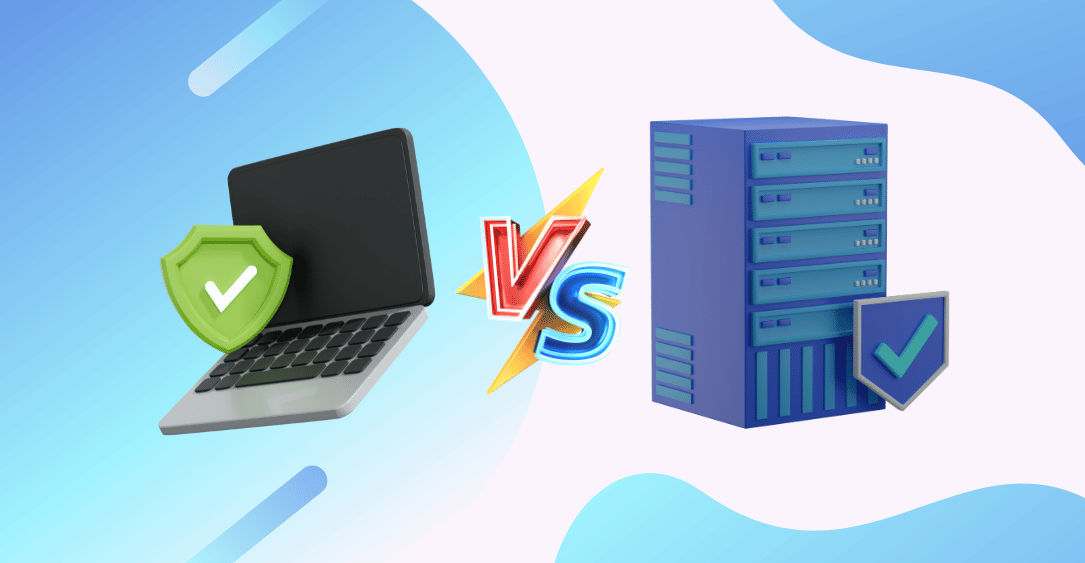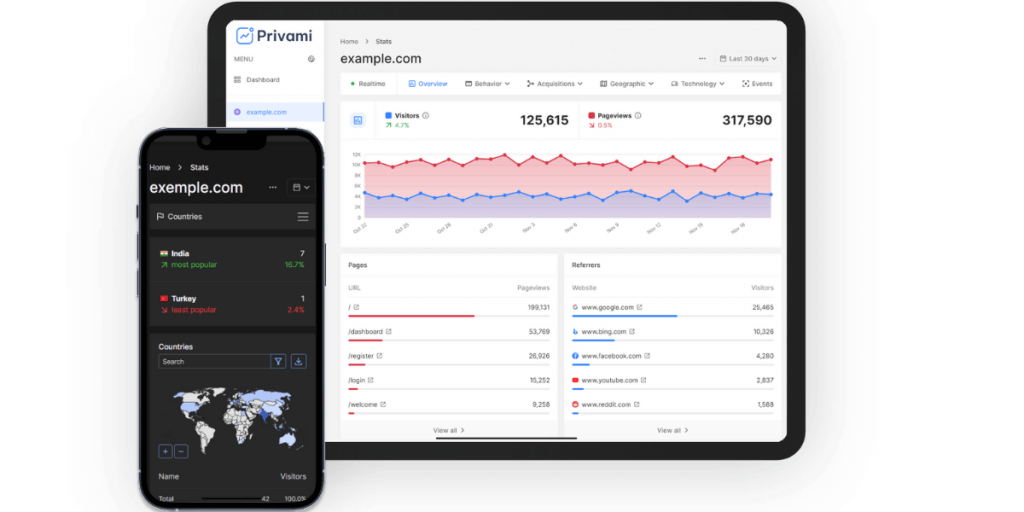
Client-side or server-side analytics
Introduction to client-side and server-side approaches
In the world of web analytics, the decision to favor a client-side or server-side approach is critical, as each offers specific advantages and challenges, particularly in terms of accuracy, ease of use, performance and privacy implications.
Client-side analytics works by integrating JavaScript into website code. It provides detailed information on user behavior on your site, capturing data on user interactions, browser events, and more. This level of detail makes it possible to track goals beyond page views, such as video playback or interactions with site features. However, a major drawback is their reliance on JavaScript, which can be blocked by ad blockers used by a notable percentage of Internet users. This can lead to inaccuracies in data collection, as these users will not be tracked. Client-side analytics are also often dependent on third-party tools, which can affect website loading times and are subject to changes in the definition of metrics by these tools.
On the other hand, server-side analytics work by monitoring server traffic, recording all requests made to the server. This approach offers the advantage of tracking users regardless of their browser settings or JavaScript blocking, ensuring a more complete capture of traffic, including those who disable JavaScript. Server-side analytics is also less invasive in terms of website load times, as it doesn’t require additional scripts to be sent with each request. However, it often counts bot traffic, leading to inflated numbers. Server logs can also be cumbersome to access and process, requiring more resources, especially on larger sites. What’s more, although server-side analytics don’t rely on cookies, they can track IP addresses, raising privacy concerns.
The decision between client-side and server-side analytics depends on the specific needs and context of your website. For critical data where accuracy is paramount, server-side analytics is preferable. It offers more control and hosts the data on your server, avoiding problems with third-party tools. For general traffic data and trends, client-side analytics is more appropriate, offering a wider range of integration capabilities and detailed data on user interactions. However, both approaches have privacy implications. Client-side analytics, especially those dependent on third-party tools, can collect vast amounts of user data, potentially encroaching on user privacy. Server-side analytics, while not dependent on cookies, can track IP addresses, which can be considered personally identifiable information. It is therefore crucial to ensure compliance with privacy laws and regulations when implementing any analytics tool.
Advantages and disadvantages of client-side and server-side analytics

The advantages and disadvantages of server-side analytics deserve particular attention if we are to fully understand their impact on web analytics.
Advantages of server-side analytics
- Minimal impact on site speed: Server-side analytics reduces the amount of code required on the site, improving page loading speed. This acceleration in site speed is crucial for conversion rate optimization, and can positively influence user experience and search engine results ranking.
- Control over shared data: You have full control over the data shared with third-party marketing platforms, which is particularly important for complying with privacy regulations such as the GDPR. This allows you to decide what data is sent and protect users’ privacy.
- Less impact of Ad Blockers: Using custom subdomains in server-side tracking helps bypass ad blockers by classifying tracking as first-party data, which also improves website loading speed.
- Extended cookie lifetime on Safari (ITP): Server-side tracking can bypass Apple’s restrictions on third-party cookies, extending their lifetime and enabling more in-depth analysis of user behavior.
Disadvantages of server-Side analytics
- Costs: Server-side analytics often require investment in cloud infrastructure and data security systems, which can represent a significant cost, especially for companies with high web traffic.
- Technical complexity and configuration: implementing server-side analytics can be technically demanding and difficult to configure correctly. It requires a specific architecture to mimic client-side queries.
- Limitations of supporting platforms: Although popular advertising platforms such as Google, TikTok and Facebook are beginning to use server-side tracking, many other platforms do not yet support it.
- Consent for personal data collection: It is important to obtain user consent when collecting personally identifiable information (PII) using server-side analytics.
Advantages of customer-side analytics
- Contextual data: Customer-side analytics offer direct access to user-specific data, such as cookies, URL parameters, user agent, referrer and IP address. This wealth of contextual data is used for actions such as ad targeting, personalization and marketing campaign analysis.
- Ease of implementation and availability of skills: Many vendors offer easy-to-implement code snippets, making client-side analytics relatively simple to install. This method is also widely used and well understood in the industry.
- Generally lower cost: Data transmission costs for client-side analytics are generally lower, as they do not require the use of third-party cloud resources as is the case for server-side monitoring.
Disadvantages of customer-side analytics
- Sensitivity to Ad Blockers and tracking prevention: Client-side analytics can be hampered by ad blockers and tracking prevention measures, which can lead to incomplete or erroneous data collection.
- Lack of data control: Unlike server-side tracking, client-side analytics often involves data being captured and managed outside your direct control, which can pose data protection risks.
- Increased privacy risks: Client-side analytics pose a higher privacy risk, as personal data often reaches third-party providers in an uncontrolled way.
- Dependence on third-party suppliers: Client-side analytics often depend on third-party suppliers for data collection and analysis, which can limit control over your website’s valuable data.
But which to choose? Client-side or server-side analytics?
When it comes to choosing between client-side and server-side web analytics, several key factors need to be taken into account to determine the most appropriate method for your website.
The nature of the data and confidentiality requirements play a crucial role in this decision. Server-side analytics offers greater data control and compliance with privacy standards, such as GDPR. This method is less likely to be affected by ad blockers, offering more reliable and comprehensive data collection. In contrast, client-side analytics can provide richer contextual data and is generally easier to implement, but is more vulnerable to ad blockers and raises privacy issues.
Technical complexity and available resources are also important. Server-side analytics may require more resources and technical expertise to implement and manage. However, it is generally more reliable as it reduces the scope of data management and allows greater control over transmission. On the other hand, client-side analytics is easier to implement and maintain, and the necessary skills are more widely available in the industry.
The budget and costs associated with each method must also be considered. Server-side analytics often involve higher costs due to the need for cloud infrastructure and data security systems. Conversely, client-side analytics is often less costly in terms of data transmission.
Ultimately, the choice between client-side and server-side analytics depends on your specific objectives, budget, technical capabilities and privacy requirements. For companies concerned with data confidentiality and accuracy, server-side analytics may be the best option. For those looking for an easier-to-implement and less expensive solution, while still offering a wealth of contextual data, client-side analytics may be more appropriate.
In some cases, a hybrid approach combining both methods may offer the best balance between data control, ease of use, and cost. This strategy leverages the benefits of each method while mitigating their respective drawbacks.
Privacy-conscious analytics alternatives
In the evolving world of web analytics, privacy considerations are becoming increasingly crucial. It’s against this backdrop that privacy-friendly alternatives such as Primavi Analytics are gaining in importance. These platforms aim to merge the user-friendliness of client-side analytics with the privacy-conscious aspects of server-side analytics, offering a more balanced approach.

Primavi Analytics, in particular, stands out for its refusal to collect personal data and its avoidance of the use of cookies, positioning itself as a privacy-friendly alternative. This method also has minimal impact on website performance, approaching the efficiency and discretion of server-side analytics.
Designed to respect user privacy while offering valuable insights into user behavior and website performance, they address growing concerns about data privacy while maintaining the utility and accessibility of web analytics.

